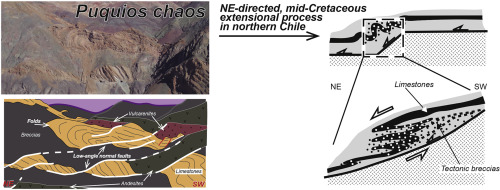当前位置:
X-MOL 学术
›
J. South Am. Earth Sci.
›
论文详情
Our official English website, www.x-mol.net, welcomes your
feedback! (Note: you will need to create a separate account there.)
Structural characteristics of the “Puquios chaos” and its relationship with the Andean middle Cretaceous extensional tectonics at 27°S, northern Chile
Journal of South American Earth Sciences ( IF 1.7 ) Pub Date : 2020-03-01 , DOI: 10.1016/j.jsames.2019.102454 Felipe Reinoso , Juan Díaz-Alvarado , Carlos Fernández
Journal of South American Earth Sciences ( IF 1.7 ) Pub Date : 2020-03-01 , DOI: 10.1016/j.jsames.2019.102454 Felipe Reinoso , Juan Díaz-Alvarado , Carlos Fernández

|
Abstract In the Precordillera of the Atacama region (~27°S), the Puquios chaos corresponds to a singular tectonic unit traditionally ascribed to a mid-Cretaceous extensional stage affecting the Mesozoic formations that were deposited between the arc and the backarc settings of the Andean margin. The melange-like unit consists of blocks of limestones in a mainly volcanic matrix that includes andesitic lavas, volcanic breccias and red vulcarenites of Upper Jurassic to Lower Cretaceous age. These rocks constitute a conformable succession of andesites, limestones and vulcarenites (from the base to the top) in the Cerro Aguila strata, observed to the south of the study area. The Puquios chaos is characterized by often isolated, tight to isoclinal folds and a set of low- and high-angle normal faults that were responsible for the block-in-matrix mesoscopic structure of the tectonic unit. These structures are easily observable in the calcareous rocks as the volcanic matrix shows a tectonically brecciated texture. The detailed structural study presented in this work allows us to propose the deformational mechanisms that finally constituted the apparently chaotic unit, including the restoration of the structures related to late contractive stages. Thus, we suggest that the singularity of the Puquios chaos is associated with a local, wide, extensional shear zone linked to a regional detachment surface. The intimate relation between recumbent folds and low- and high-angle normal faults, besides the similar orientation of fold hinges and fault planes, point to the actuation of a brittle-ductile shear zone where the calcareous competent layers gave rise to decametric-scale folds as the volcanic matrix responded to strain by brecciation. Stretching calculations carried out in a domino fault system yielded horizontal extension of around 30% for the high-angle faults. We obtained a relative age of the Puquios chaos formation according to the field relations and the structural determinations. A NE-directed intense extensional stage promoted a significant crustal thinning that exhumed but not affected the late Paleozoic basement. The Puquios structures and the related regional detachments affected the pre-Barremian arc and back-arc formations and were unconformably covered by the latest Cretaceous and Paleocene thick volcanic and volcanosedimentary deposits.
中文翻译:

“Puquios混沌”构造特征及其与智利北部27°S安第斯中白垩世伸展构造的关系
摘要 在阿塔卡马地区前科迪勒拉 (~27°S),普基奥斯混沌对应于一个单一的构造单元,传统上归因于白垩纪中期伸展阶段,影响沉积在弧和安第斯弧后环境之间的中生代地层。利润。混杂岩单元由主要火山基质中的石灰岩块组成,包括安山岩熔岩、火山角砾岩和上侏罗纪至下白垩纪时代的红色火山岩。在研究区南部观察到的 Cerro Aguila 地层中,这些岩石构成了安山岩、石灰岩和硫化岩(从底部到顶部)的一致序列。Puquios 混乱的特点是经常孤立,紧至等斜褶皱和一组低角度和高角度正断层,这些正断层是构造单元的块状基质细观结构的原因。这些结构在钙质岩中很容易观察到,因为火山基质显示出构造角砾岩结构。这项工作中提出的详细结构研究使我们能够提出最终构成明显混沌单元的变形机制,包括与后期收缩阶段相关的结构的恢复。因此,我们认为 Puquios 混沌的奇点与一个局部的、宽的、伸展的剪切带有关,该剪切带与区域脱离表面相连。横卧褶皱与低、高角度正断层的密切关系,除了褶皱铰链和断层面的相似取向外,指出脆性 - 韧性剪切带的驱动,其中钙质主管层在火山基质响应角砾岩化应变时产生了十米级褶皱。在多米诺断层系统中进行的拉伸计算为大角度断层产生了大约 30% 的水平延伸。根据场关系和结构测定,我们得到了Puquios混沌地层的相对年龄。NE 导向的强烈伸展阶段促进了显着的地壳变薄,该变薄已开采但未影响晚古生代基底。Puquios 构造和相关的区域拆离影响了前巴雷米亚弧和弧后地层,并且被最新的白垩纪和古新世厚火山和火山沉积沉积物不整合地覆盖。
更新日期:2020-03-01
中文翻译:

“Puquios混沌”构造特征及其与智利北部27°S安第斯中白垩世伸展构造的关系
摘要 在阿塔卡马地区前科迪勒拉 (~27°S),普基奥斯混沌对应于一个单一的构造单元,传统上归因于白垩纪中期伸展阶段,影响沉积在弧和安第斯弧后环境之间的中生代地层。利润。混杂岩单元由主要火山基质中的石灰岩块组成,包括安山岩熔岩、火山角砾岩和上侏罗纪至下白垩纪时代的红色火山岩。在研究区南部观察到的 Cerro Aguila 地层中,这些岩石构成了安山岩、石灰岩和硫化岩(从底部到顶部)的一致序列。Puquios 混乱的特点是经常孤立,紧至等斜褶皱和一组低角度和高角度正断层,这些正断层是构造单元的块状基质细观结构的原因。这些结构在钙质岩中很容易观察到,因为火山基质显示出构造角砾岩结构。这项工作中提出的详细结构研究使我们能够提出最终构成明显混沌单元的变形机制,包括与后期收缩阶段相关的结构的恢复。因此,我们认为 Puquios 混沌的奇点与一个局部的、宽的、伸展的剪切带有关,该剪切带与区域脱离表面相连。横卧褶皱与低、高角度正断层的密切关系,除了褶皱铰链和断层面的相似取向外,指出脆性 - 韧性剪切带的驱动,其中钙质主管层在火山基质响应角砾岩化应变时产生了十米级褶皱。在多米诺断层系统中进行的拉伸计算为大角度断层产生了大约 30% 的水平延伸。根据场关系和结构测定,我们得到了Puquios混沌地层的相对年龄。NE 导向的强烈伸展阶段促进了显着的地壳变薄,该变薄已开采但未影响晚古生代基底。Puquios 构造和相关的区域拆离影响了前巴雷米亚弧和弧后地层,并且被最新的白垩纪和古新世厚火山和火山沉积沉积物不整合地覆盖。











































 京公网安备 11010802027423号
京公网安备 11010802027423号